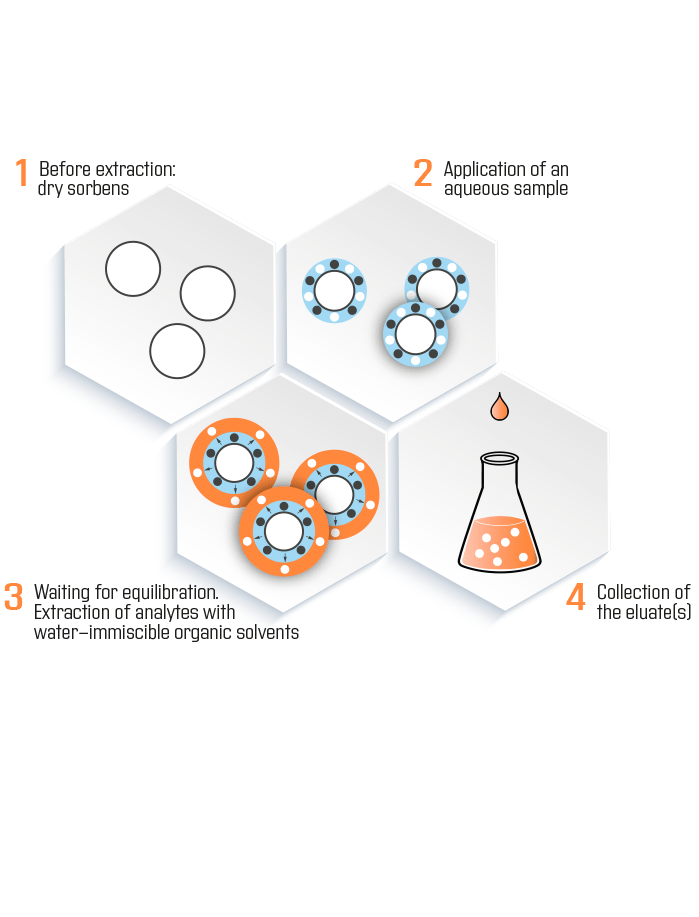
The principle of “solid-supported” liquid extraction (SLE) is analogous to conventional liquid-liquid extraction (LLE). The same water-immiscible solvents and mixtures are used. However, a single extraction “on the cartridge” is sufficient to achieve recoveries comparable to LLE. The sample solution is uniformly spread as a thin film on an inert, wide-pored diatomaceous earth. After a waiting period of 5-10 minutes, which serves to establish equilibrium, the organic eluent flows through the pores of the sorbent and extracts the analytes into the organic phase.
The better the analyte is soluble in organic solvent and the worse in water, the higher the extraction yield.
Sample preparation with BEKOlut® SLE columns and 96-well plates is essentially carried out under hydrostatic pressure (gravity), whereby a start impulse with vacuum or overpressure can be quite useful in order to apply the sample evenly to the dry column/plate or to recover the solvent to a maximum after elution. Both manual and automated, vacuum or pressure systems are used.
The diatomaceous earth specially processed for SLE has a pH of 9-10 in an aqueous environment, i.e. acidic analytes have to be adjusted to a higher acidity in the sample, whereas a pH adjustment is not necessary for basic analytes.
Another advantage for bioanalytics: Protein- and phospholipid-free extracts. In the more lipophilic extraction solvents used in LLE and SLE, proteins, polar (phospho) lipids and salts are only very poorly soluble to insoluble and are thus largely excluded from the extract. This means that the resulting extracts are free of interfering proteins and phospholipids.
In contrast to SPE, where generally only an aliquot of the sample is loaded onto the conditioned SPE column, in SLE the entire sample volume is loaded onto the dry cartridge bed. It is therefore essential to use a column with sufficient volume capacity. After equilibration (after approx. 5-10 min) it is useful, especially when using eluents containing alcohol, to have a few millimeters of reserve at the lower end of the cartridge so that the aqueous sample solution does not “break through” during elution.
The sample volume to be added is printed on the cartridge, e.g. SLE 1 is suitable for adding 1 mL aqueous sample volume. Elute with 2-3 times the sample volume. Table 1 gives an overview of maximum sample and elution volumes.
The selectivity of the extraction is determined by the solubility of the analytes in the organic phase. Typical solvents are: Diethyl ether, tert-butyl methyl ether, ethyl acetate, n-hexane, cyclohexane, toluene, dichloromethane, trichloromethane.
For example, the following solvent mixtures with a small polar fraction are used for less non-polar analytes. Composite mixtures containing alcohol must not be miscible with water.
Diethyl ether – ethanol (80:20, v/v)
Dichloromethane – 2-propanol (85:15, v/v)
For pure aqueous samples such as blood, serum, plasma, dichloromethane-2-propanol (85:15, v/v) is an ideal elution solvent.
Table 1: Maximum sample and necessary elution volumes for BEKOlut® SLE product
| Volume capacity | Max. sample volume | Elution volume |
|---|---|---|
| 200 µL 96-well Plate | 200 µL | 1 x 1 mL |
| 400 µL 96-well Plate | 400 µL | 2 x 900 µL |
| 1 mL Column | 1 mL | 2 x 2,5 mL |
| 2 mL Column | 2 mL | 2 x 5 mL |
| 5 mL Column | 5 mL | 3 x 8 mL |
| 10 mL Column | 10 mL | 2 x 20 mL |
| 20 mL Column | 20 mL | 2 x 40 mL |
| 50 mL Column | 50 mL | 2 x 60 mL |






 THE PROPERTIES
THE PROPERTIES 




